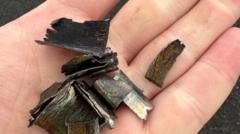Hundreds of cars were rendered inoperable after a truck spilled approximately 750kg (1,653lb) of sharp metal shards across the M1 Pacific Motorway, one of Australia’s busiest highways. The incident occurred early Friday morning, prompting city-bound lanes to remain closed for several hours as authorities worked to manage the fallout. According to the New South Wales Rural Fire Service, at least 300 vehicles, including emergency response units, suffered severe tyre damage due to the sharp debris, which went undetected for 30km (18 miles).
"At around 5am, a truck lost its load of scrap metal, which resulted in extensive debris scattered along the roadway," the fire service reported. New South Wales state police confirmed that the spillage happened near Ourimbah, just north of Sydney. After being closed for nearly 10 hours, the motorways were reopened later in the afternoon.
The truck, operated by the company NJ Ashton, is currently under scrutiny as it expressed its apologies for the situation and committed to assisting in the cleanup efforts. Authorities have been employing specialized magnetic devices to remove metal pieces that have become embedded in the highway itself. "This isn't as simple as deploying a road sweeper or laborers with brooms; cleaning requires advanced equipment and considerable time," explained state highway patrol commander Howard Collins during a press briefing.
According to State Roads Minister Jenny Aitchison, the event has been classified as "unprecedented," prompting extensive collaboration between governmental and private entities to facilitate the cleanup. "It's akin to trying to vacuum the highway—an arduous challenge," she stated.
The truck driver, a 46-year-old male, is cooperating with police investigations. In a statement on NJ Ashton's website, the company expressed regret over the damage and inconvenience caused, admitting, "We still do not fully understand how this incident occurred." The truck's journey of over 30km (18.64 miles) with debris trailing behind before the issue was identified has raised numerous questions regarding oversight and prevention in the transportation of scrap material.


















